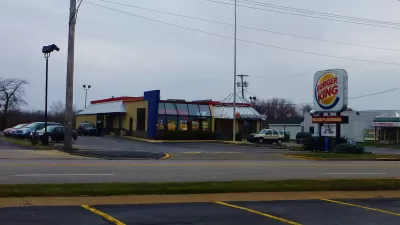Gina Kolata reports on the findings of two new studies that question the very concept of food deserts in poor neighborhoods, and the connection between fresh food access and obesity.
The idea that many poor urban neighborhoods lack access to fresh food (food desert), which contributes to childhood obesity rates in such areas, has become a common cause driving planning and policy makers across the country, including Michelle Obama's signature Let's Move campaign. As Kolata reports, two new studies have raised serious questions about the premise behind both ideas.
Helen Lee, of the Public Policy Institute of California, published a study in the March issue of Social Science and Medicine, questioning the common occurrence of food deserts in poor urban neighborhoods. "Poor neighborhoods, Dr. Lee found, had nearly twice as many fast food restaurants and convenience stores as wealthier ones, and they had more than three times as many corner stores per square mile. But they also had nearly twice as many supermarkets and large-scale grocers per square mile."
The other study mentioned in the article focused on the connection between fresh food access and childhood obesity rates. That study, authored by Roland Sturm of the RAND Corporation, and published in February in The American Journal of Preventive Medicine, "found no relationship between what type of food students said they ate, what they weighed, and the type of food within a mile and a half of their homes," writes Kolata.
Although "Some experts say these new findings raise questions about the effectiveness of efforts to combat the obesity epidemic simply by improving access to healthy foods," the goal of increasing access to fresh foods is just one of a host of efforts intended to combat America's obesity epidemic. Mrs. Obama's initiative, for example, also stresses improving food in schools, increasing physical education time, and educating people on the importance of healthy diets, as Kolata notes.
FULL STORY: Studies Question the Pairing of Food Deserts and Obesity

Planetizen Federal Action Tracker
A weekly monitor of how Trump’s orders and actions are impacting planners and planning in America.

Maui's Vacation Rental Debate Turns Ugly
Verbal attacks, misinformation campaigns and fistfights plague a high-stakes debate to convert thousands of vacation rentals into long-term housing.

San Francisco Suspends Traffic Calming Amidst Record Deaths
Citing “a challenging fiscal landscape,” the city will cease the program on the heels of 42 traffic deaths, including 24 pedestrians.

Amtrak Rolls Out New Orleans to Alabama “Mardi Gras” Train
The new service will operate morning and evening departures between Mobile and New Orleans.

The Subversive Car-Free Guide to Trump's Great American Road Trip
Car-free ways to access Chicagoland’s best tourist attractions.

San Antonio and Austin are Fusing Into one Massive Megaregion
The region spanning the two central Texas cities is growing fast, posing challenges for local infrastructure and water supplies.
Urban Design for Planners 1: Software Tools
This six-course series explores essential urban design concepts using open source software and equips planners with the tools they need to participate fully in the urban design process.
Planning for Universal Design
Learn the tools for implementing Universal Design in planning regulations.
Heyer Gruel & Associates PA
JM Goldson LLC
Custer County Colorado
City of Camden Redevelopment Agency
City of Astoria
Transportation Research & Education Center (TREC) at Portland State University
Jefferson Parish Government
Camden Redevelopment Agency
City of Claremont



























